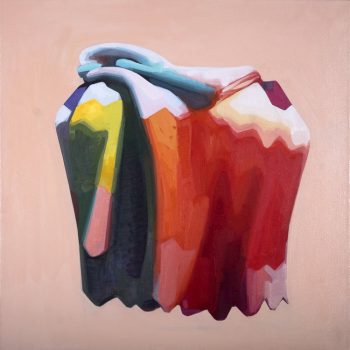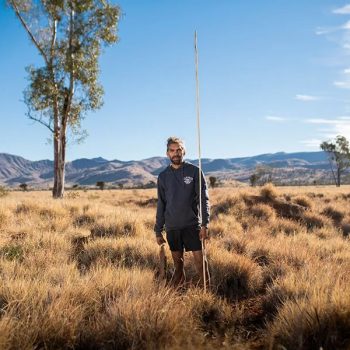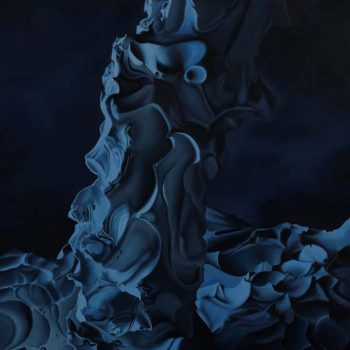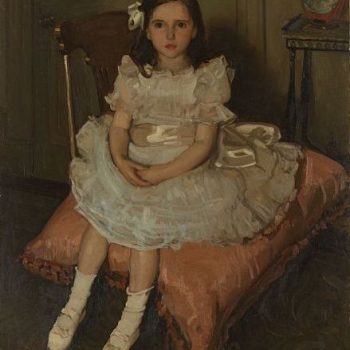American Masters 1940 – 1980
on show until 11 Nov 2018 at National Gallery Australia (NGA)
From Abstract Expressionism, Colour Field, Pop, Neo-Dada and Photo-Realism, to Conceptual, Land and Performance Art, American Masters examines how a generation of young Americans challenged local traditions and reinvented modern art.
How Jackson Pollock’s drips and drabs became a symbol of modern Australia
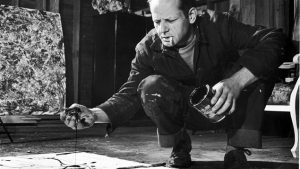
…the deference that Australians have for this artwork does not come from a sophisticated appreciation of Pollock’s legendary drip-painting technique. Rather, it is inspired by the work’s unlikely status as an emblem of their country’s modernity.
For many Australians, the chaos on the canvas represents the political chaos of the 1970s, and the birth of a national identity distinct from Britain’s.
After his defeat by Malcolm Fraser, Gough Whitlam commented in 1976: No country has a greater need than Australia, remote as we are from the great galleries of the world, to acquire works of art from other nations and civilisations…Overseas galleries have always recognised that the function of any gallery other than the most provincial is to offer a comprehensive view of world culture.
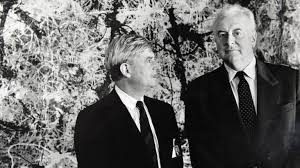
The $1.3 million price tag was an American and Australian world-record at the time and sparked a fierce political debate about political extravagance and the value of abstract art.
Journalist Latika Bourke from the SMH wrote in 2016
Blue Poles is now estimated to be worth up to $100 million.
NATIONAL GALLERY OF AUSTRALIA (NGA)
Analysis of Blue Poles by Anthony White in response to the current American Masters exhibition
Blue poles 1952 is one of the most famous paintings in the Gallery’s collection. First exhibited at Jackson Pollock’s solo show at Sidney Janis Gallery in 1952, where it was listed as Number 11, 1952,[1] it was later titled by the artist Blue poles.[2]
In 1973 Stanley P Friedman wrote an article in the New York Magazine in which he reported being told by Tony Smith that he and Barnett Newman had painted on the canvas that subsequently became Blue poles.[3] No-one who Friedman interviewed for his article refuted the possibility that Smith or Newman contributed to the early stages of the work. What they all denied emphatically is that these initial exercises contributed in any way to the work that Pollock then built up on the canvas to become Blue poles—any trace of earlier involvement by Smith or Newman was covered over by the painting that Pollock subsequently made on the canvas.

The first layer of paint was applied, as had been customary practice for Pollock since 1947, while the canvas was stretched out on the floor.[4] The earliest visible layer of paint is black, thinning at the edges to a green, which appears to have been formed by the mixing of yellow and black, embedded with fragments of the glass basting tubes that were used to apply the first layers of paint to the canvas. Subsequently the unstretched canvas was tacked to a beam that ran along the wall of the studio; liquid white paint was then applied and allowed to run down.
For Pollock’s next campaign the canvas was returned to the floor.
Using his characteristic method of pouring fluid paint in a continuous stream onto the canvas from above, employing sticks, dried brushes and syringes, Pollock built up a web of rhythmic linear accents using yellow, orange and aluminium paints.
He then left the canvas to dry. When he next worked on the painting he added in the blue poles, apparently using a ‘2 x 4’ length of timber as a straight edge,[5] creating unusually definite forms in the ‘all‑over’ configuration of the work. Various figurative connotations have been attributed to them—from totems to the swaying masts of tall ships.[6]
Pollock integrated the poles by lacing them into the composition with fine dripped skeins of white, black and blue paint. In this final operation the artist used brushes and rags as well as poured paint.
Careful adjustments were made, such as fastidiously painting over a thin white dripped line at the left edge of the canvas in black. In many respects, the approach in Blue poles is similar to Pollock’s earlier works; the painting is built up with successive layers of dripped and poured paint evenly dispersed across the canvas. However, it also differs in a number of important ways, not least of which are the strong vertical elements of the ‘poles’. This departure was both a reprise of a recurrent motif in Pollock’s work and a self-conscious re-evaluation of the painting technique for which he was famous.
Anthony White[7]
[1] Although the date of the painting is definitely 1952, Pollock appears to have mistakenly dated it ‘53’, then painted over the ‘3’ to a ‘2’.
[2] Sidney Janis, correspondence with the National Gallery, 17 January 1986. Pollock himself referred to the painting as Blue poles in a conversation with BH Friedman in 1955, see BH Friedman, Jackson Pollock: Energy made visible, McGraw-Hill, New York, 1972, p xvii.
[3] Stanley P Friedman, ‘Loopholes in “Blue Poles”’, New York Magazine, 29 October 1973, pp 48–51.
[4] The canvas is high‑quality Belgian linen with a commercially oil‑primed ground.
[5] Lee Krasner Pollock recalled seeing this piece of wood near the painting covered with wet blue paint, see Francis Valentine O’Connor and Eugene Victor Thaw, Jackson Pollock: A catalogue raisonné of paintings, drawings and other works, 4 vols, Yale University Press, New Haven and London, 1978, vol 2, p 193.
[6] In his biography of Pollock, Bryan Robertson attributes both connotations to the poles, and also suggests a cruciform and an anchor; see Bryan Robertson, Jackson Pollock, Thames & Hudson, London, Harry N Abrams, New York, 1960, pp 23–4.
[7] Adapted and updated from Michael Lloyd and Michael Desmond, European and American Paintings and Sculptures 1870–1970 in the Australian National Gallery, Australian National Gallery, Canberra, 1992, pp 240–5



